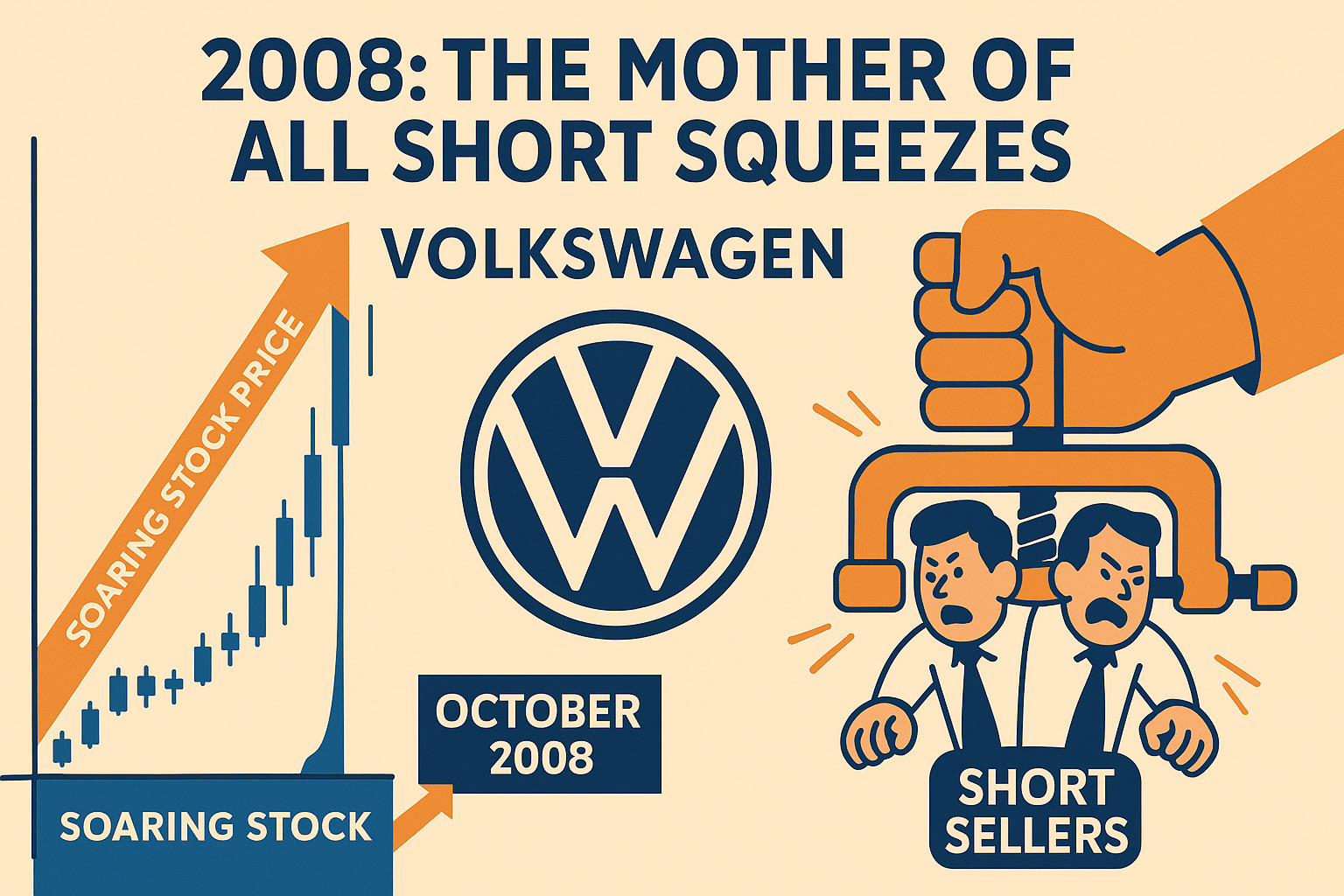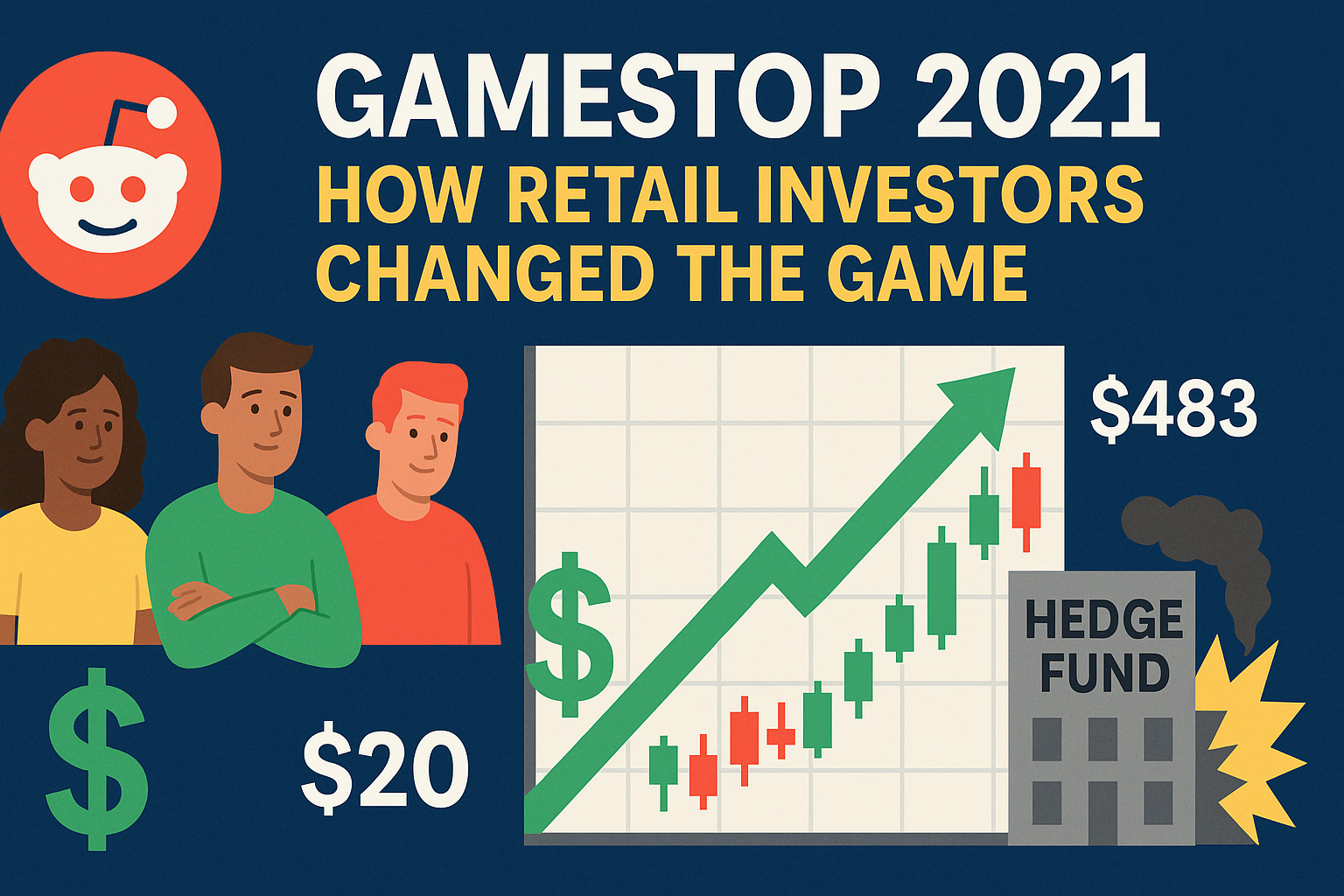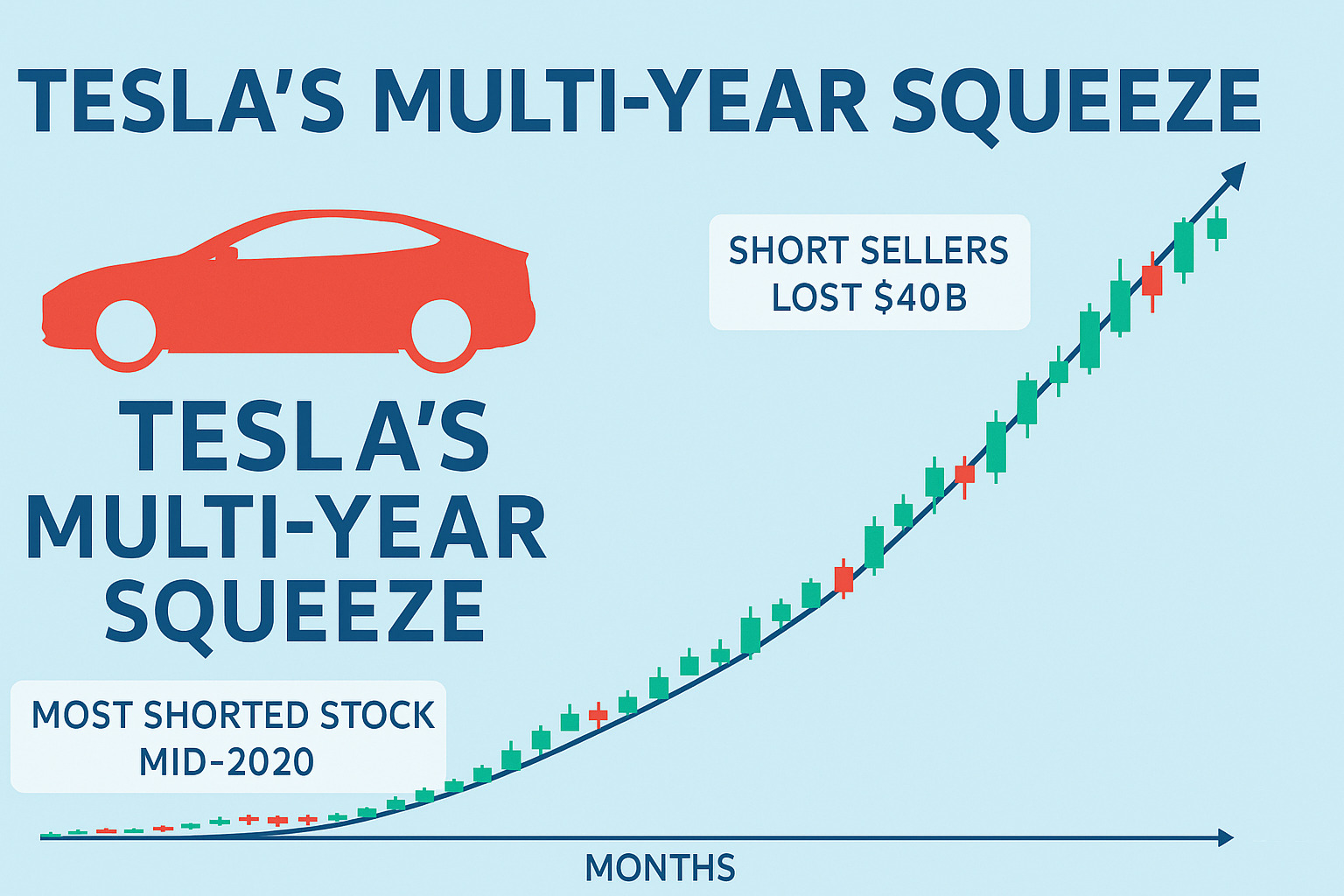What is a Short Squeeze: The Hidden Force Behind Stock Price Surges

A short squeeze is a sharp stock price increase triggered when short sellers are forced to buy back shares to cover losses. This creates a self-reinforcing cycle of buying, often causing extreme price spikes driven by panic, FOMO, and limited share availability.
Picture this: A stock rockets from $2 to more than $120 in a matter of weeks. GameStop’s remarkable price surge at the time of January 2021 demonstrated the sheer impact of a short squeeze. Such market events can drive stock prices up to 50 times their original value within brief time spans.
A short squeeze is a unique market event. It happens when rising prices force short sellers to buy back shares, driving prices even higher.
One of the most famous examples was Volkswagen in 2008. Its stock jumped over 300% in days, briefly making it the most valuable company in the world.
This guide explains how short squeezes work and how to spot early warning signs like high short interest ratios.
You’ll learn key lessons from historical cases that moved markets. We’ll also explore what triggers these events and why they attract both retail and institutional investors.
- A short squeeze happens when rising stock prices force short sellers to buy back shares, creating more upward pressure.
- Key signals include high short interest (20%+), days to cover above 5, and unusual trading volume or breakouts on charts.
- Emotional triggers like FOMO and herd behavior can fuel irrational price surges during a squeeze.
- Historic squeezes like GameStop (2021), Volkswagen (2008), and Tesla’s multi-year run highlight different squeeze dynamics.
- Short squeezes offer major profit potential—but also high risk—as prices often collapse back to fundamental levels post-surge.
What is a Short Squeeze: Mechanics Behind the Market Phenomenon
A short squeeze is a powerful market event that forces short sellers to rush and cover their positions. This creates a cycle of buying pressure that feeds on itself. Unlike regular price increases, these events can trigger dramatic price surges faster than anyone expects. The prices seem to have no connection to what the company is actually worth.
The Basic Definition of a Short Squeeze Explained
Short squeezes happen when a heavily shorted security sees an unexpected price jump. Short sellers borrow and sell shares because they think prices will go down. They face mounting losses when prices go up instead of down. These sellers must buy shares to close their positions—a process called “covering.” More buying pushes prices higher and forces other short sellers to cover. This creates a snowball effect that keeps growing.
How Short Selling Creates Vulnerability in Markets
The way short selling works sets the stage for potential squeezes. Investors who short a stock borrow shares from brokers and sell them right away. They plan to buy them back later at lower prices. This strategy comes with big risks. Regular investing limits your losses to what you put in, but short sellers could lose unlimited amounts if prices rise. Short sellers also use margin accounts that need minimum equity levels. Brokers might issue margin calls if prices rise by a lot. This forces sellers to close positions whatever their market outlook might be.
The Trigger Points That Initiate a Squeeze
Different events can kick off a short squeeze. Good news nobody expected—like strong earnings reports, new product launches, or positive industry updates—can change a stock’s outlook faster than anticipated. Stocks with high short interest ratios (usually 5 or above) and low floats face higher squeeze risks. Technical factors matter too. Unusual patterns in trading volume and higher volatility often show a squeeze might happen soon. These aren’t random events. Short squeezes often pop up during uncertain market times or in sectors that depend on speculative technologies.
Key Indicators That Signal a Potential Short Squeeze
Traders need to watch several market indicators to spot a potential short squeeze before it happens. The most successful ones look for specific signals that predict these powerful price movements.
Short Interest Ratio: The Primary Warning Sign
Short interest shows the total number of shares sold short but not yet covered as a percentage of outstanding shares. This metric acts as the basic indicator of squeeze potential. A short interest above 20% shows heavy negative sentiment and higher squeeze risk. So, a short interest under 10% usually means low squeeze potential, while 10-20% points to moderate risk. Most stocks have single-digit short interest percentages, and any reading above 10% needs careful attention.
Days to Cover: Measuring Squeeze Intensity
Days to Cover (also called short interest ratio) tells us how long short sellers would need to buy back all borrowed shares based on average daily trading volume. The calculation divides the number of shares sold short by the stock’s average daily volume. A Days to Cover ratio above 5 points to serious squeeze potential, and readings above 6 show high risk. Short sellers face real trouble when the days-to-cover goes beyond 8 days.
Unusual Trading Volume Patterns
Sharp jumps in trading volume often come before or during early stages of a short squeeze. Price increases with rising volume show strong market belief and verify the emerging trend. Heavy trading volume points to strong conviction, while light volume hints at uncertainty. The squeeze gets extra momentum when volume picks up during price rises as short sellers start to cover their positions.
Technical Chart Patterns That Precede Squeezes
Chart patterns help traders spot potential squeezes early. Short covering often starts when prices break past resistance levels. The “day three surge pattern” begins with a big up day on major news, then moves sideways to trap shorts, before breaking above recent highs. The TTM Squeeze indicator looks at how Bollinger Bands and Keltner Channels relate to find consolidations before breakouts.
Psychological Forces Driving Short Squeeze Momentum
Stock prices move beyond rational levels when psychological forces fuel short squeeze momentum. These emotional factors push prices higher than what fundamental analysis would suggest.
Fear of Missing Out (FOMO) as a Catalyst
FOMO acts as a powerful emotional trigger that makes short squeezes more intense through waves of buying pressure. Stock prices shoot up faster during a squeeze, and investors on the sidelines rush to join in.
This creates a cycle where more buying leads to even higher prices. The effect goes deeper than just people worried about missing opportunities – it’s an emotional spark that can send stock prices soaring.
Traders get caught up in FOMO as prices climb faster, which leads to more buying and pushes prices even higher. Social media platforms like Reddit magnify this effect by spreading information (or misinformation) quickly, making investors feel pressured to act right away.
Short Seller Psychology Under Pressure
Short squeezes create unique mental stress for short sellers. Regular investors can only lose what they put in, but short sellers face unlimited losses as prices climb. This one-sided risk creates growing panic as losses pile up. After taking big hits during a squeeze, short sellers become more careful and reduce their short positions.
On top of that, it forces short sellers to close their positions when good news or sudden buying pushes stock prices up, even if they still believe in their original strategy. The mental toll spreads beyond individual traders – as more short sellers exit under pressure, market sentiment shifts and prices become more volatile.
The Herd Mentality Effect on Price Movements
Herd behavior makes short squeezes more intense through group action. People demonstrate this behavior by copying what the larger group does instead of doing their own research.
The GameStop short squeeze showed how retail investors worldwide used social platforms to limit available shares for covering short positions, which pushed prices way above reasonable values.
A mix of information sharing and collective feelings against big finance companies led to wild price swings. Herd mentality creates market bubbles that eventually burst, but the momentum can wipe out short positions before any correction happens.
Psychological Forces Driving Short Squeeze Momentum
Market events are shaped more by psychology than technical factors. Short squeezes combine three psychological forces that create explosive price movements. These movements often go beyond traditional valuation metrics.
Fear of Missing Out (FOMO) as a Catalyst
FOMO acts as a powerful emotional trigger that makes short squeezes more intense. Stock prices rise dramatically and investors rush to join in from the sidelines. Their buying creates additional pressure that pushes prices even higher. This emotional catalyst makes stock prices jump beyond rational expectations.
Social media makes this effect even stronger. Market buzz and viral trends spread faster on these platforms. Investors feel pressured to act quick without proper analysis. The spotlight from influencers on surging stocks turns FOMO into a self-fulfilling cycle. Prices climb higher as more people just need to get in.
Short Seller Psychology Under Pressure
Short sellers face unique psychological stress during squeezes. Regular investors can only lose their original investment. Short sellers, however, could face unlimited losses. This reality leads to growing panic as losses pile up. Many hold onto their bearish views at first and short more shares at higher prices.
In spite of that, their stress levels shoot up as they run out of shares to borrow and face higher margin requirements. Short sellers who lose big money become more careful later. They end up reducing their bets against similar stocks in the future.
The Herd Mentality Effect on Price Movements
Herd behavior makes short squeezes more powerful through coordinated action. The GameStop event showed how retail investors united globally on social platforms. They reduced the available shares needed to cover short positions and drove prices beyond fundamental values.
Information sharing and collective sentiment against Wall Street created wild price swings. We followed the crowd because we thought others knew more during uncertain times. This group behavior creates bubbles that eventually burst. The momentum can still destroy short positions before any correction happens.
Anatomy of Famous Short Squeezes in Market History
Market history has several short squeezes that changed trading dynamics forever. These case studies show how short squeeze mechanics play out on the ground with dramatic outcomes.
Volkswagen 2008: The Mother of All Short Squeezes

Volkswagen’s 2008 squeeze stands as the most dramatic event in financial history. Porsche shocked the market on October 26, 2008, when it announced control of 74.1% of Volkswagen’s voting shares. The German state of Lower Saxony held another 20%, which left only 6% of shares in the market. Short sellers faced an impossible situation as 12% of VW’s outstanding shares were sold short. VW’s stock price shot up from €210.85 to over €1,005 in just two days. The company briefly became the world’s most valuable with a market cap of €296 billion. Hedge funds ended up losing about $30 billion from their short positions.
GameStop 2021: How Retail Investors Changed the Game

GameStop’s squeeze took a different path from Volkswagen’s case. Bloomberg reported that 144% of GameStop’s float was sold short, which created perfect conditions to squeeze. Reddit users from WallStreetBets forum started buying shares in January 2021. The stock jumped from $20 to $483 in just over two weeks. Several hedge funds took heavy losses from this collective action. Melvin Capital’s value dropped by 53% in January alone. This event showed how retail investors could challenge big institutions through social media.
Tesla’s Multi-Year Squeeze: A Different Pattern

Tesla’s case shows a different kind of squeeze that lasted years. Tesla became the world’s most shorted stock by mid-2020. Wall Street thought the company was worth too much. The stock kept climbing through 2020 against all expectations. Short sellers lost around $40 billion by year’s end. Tesla’s share price got help from ESG investing trends and strong financial results. Unlike VW and GameStop’s quick squeezes, Tesla’s squeeze took months to unfold and caused losses slowly.
How Different Investors Navigate Short Squeezes
Short squeezes create unique challenges and chances for market participants of all types. Each investor type uses different strategies to handle these turbulent market events.
Retail Investor Strategies: Opportunities and Pitfalls
Retail investors see short squeezes as both an opportunity and a risk. The GameStop event showed how coordinated retail activity through platforms like Reddit created unprecedented price movements. These investors face serious dangers. Anyone buying stocks in squeeze territory needs extreme caution. Prices usually return to their original values after the squeeze ends. Retail traders should remember to:
- Research company fundamentals instead of following the crowd
- Set clear profit targets with stop-loss orders to protect against volatility
- Stay away from positions where prices have already shot up
Social media platforms help retail investors spot heavily shorted stocks and coordinate buying pressure, as the GameStop phenomenon proved. Early participants can see big returns but latecomers often lose money.
Institutional Approaches to Short Squeeze Events
Institutional investors use more sophisticated risk management strategies to handle short squeezes. They look at vulnerability assessments to spot potential attack vectors from short activists. These big players watch short interest metrics and keep strong communication strategies ready to fight negative stories. Unlike retail traders, institutions study past squeezes to build systematic responses rather than making quick decisions.
Short Sellers’ Defensive Tactics During a Squeeze
Short sellers caught in a squeeze need vital defensive tactics to survive. Many keep their bearish outlook when prices rise unexpectedly—some even increase their positions at higher prices. Smart short sellers use specific defensive measures as pressure builds up. They use stop orders to limit losses and spread short positions across multiple securities to cut concentration risk. Professional short sellers also track days-to-cover ratios and utilization rates to measure squeeze intensity.
Short sellers face unlimited losses because prices can keep rising forever. This risk explains why many 10-year old investors avoid short selling, whatever they think about a security’s value.
Conclusion
Short squeezes present both significant opportunities and considerable risks, as stock prices can detach from fundamental values with surprising speed. Identifying potential squeezes early by monitoring short interest ratios above 20% and days-to-cover exceeding 5 can offer a strategic advantage. Historical examples, from Volkswagen’s rapid ascent to Tesla’s prolonged climb and GameStop’s retail-driven surge, underscore the diverse nature of these events.
Success in navigating short squeezes requires a blend of technical analysis and an understanding of market psychology, particularly the impact of FOMO and herd behavior. Ultimately, traders must carefully assess whether the high-reward potential aligns with their individual investment strategy and risk tolerance. Prudent position sizing and a well-defined exit strategy are essential to managing the inevitable price corrections following these volatile market phenomena.
Frequently Asked Questions
1. What exactly is a short squeeze in the stock market?
A short squeeze occurs when a stock’s price rises unexpectedly, forcing short sellers to buy back shares to cover their positions. This increased buying pressure further drives up the price, creating a self-reinforcing cycle that can cause dramatic price increases in a short period.
2. Who typically benefits from a short squeeze?
Investors holding long positions in the stock generally benefit from a short squeeze. As short sellers rush to cover their positions, the increased demand drives up the stock price, potentially leading to significant gains for those who already own shares.
3. What are the key indicators that a short squeeze might occur?
Important indicators include a high short interest ratio (typically above 20% of float), days to cover exceeding 5, unusual trading volume patterns, and certain technical chart formations. These factors can signal increased vulnerability to a potential squeeze.
4. How do retail investors approach short squeezes differently from institutional investors?
Retail investors often use social media platforms to identify heavily shorted stocks and coordinate buying pressure, as seen in the GameStop event. Institutional investors, on the other hand, typically employ more sophisticated risk management strategies and conduct thorough vulnerability assessments.
5. What risks should investors be aware of when participating in a short squeeze?
While short squeezes can offer dramatic profit potential, they also carry substantial risks. Prices often return to fundamental values after the squeeze subsides, which can lead to significant losses for latecomers. It’s crucial for investors to exercise caution, set clear profit targets, and use stop-loss orders to protect against volatility.
